All stereoscopic projection systems have one thing in common, they need to independently present a left and right eye image to the corresponding eye. If the two images are formed correctly then the human visual system will give the viewer the strong sense of depth he/she is familiar with when viewing the world with two eyes. Presenting stereo pairsThe stereoscopic display being discussed here is known as passive stereo, this is refering to the glasses which have no electronic componants. So called active stereo systems use glasses with LCD shutters and electronics which change the state of the LCD from transparent to opaque very quickly and in synchrony with the projection of the stereo pairs. Passive stereo projection typically has two projectors, one for the left eye and one for the right eye image. The lens of each projector is covered with a linear polarising filter that are at right angles to each other (circular polarisers can also be used). The glasses have similarly orientated polaroid filters, the net result being that light from the left projector which may be orientated by the polaroid filter at +45 degrees reaches the left eye which has the polaroid also at +45 degrees but not the right eye because the right eye polaroid is at -45 degrees. A similar situation applies for the right eye, it only receives an image from the right eye projector. 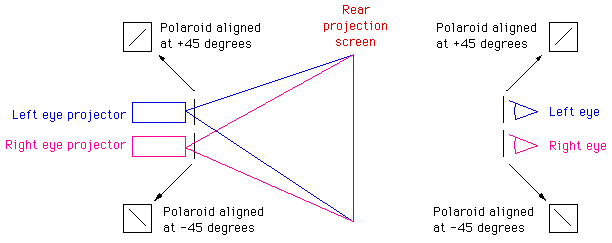
Off-Axis frustum There are two ways of creating stereo pairs, both work but one is the correct way and other less correct. The correct off-axis method will be outlined here followed by the incorrect toe-in method. The incorrect method is included mainly so that it will be recognized since it is still used by some packages. It is still used because it is often easier to implement, the reason for not using it is because it induces increased eyestrain. Definition: The frustum is the rectangular wedge that one gets if a line is drawn from the eye to each corner of the projection plan, for example, the screen. In the diagrams that follow the view will typically be that of looking down on the camera frustum from directly above. There is no vertical parallax and we aren't considering the cases of a vertical offaxis frustum since we're assuming the viewer is located centrally to the projection plane (screen). 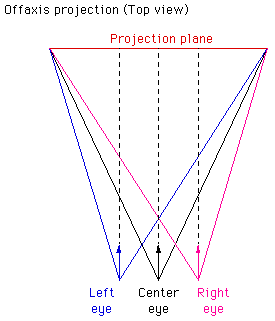
In the diagram above the solid black wedge is the symmetric frustum most commonly used in computer graphics. In stereographics the frustums that need to be created are shown in red and blue. Note that the left and right cameras are parallel to each other. Incorrect "toe-in" methodThe toe-in method rotates the camera frustum so that the two camera direction vectors meet at the focal length. The consequence of this is that a symmetric frustum is all that is required for all eyes. 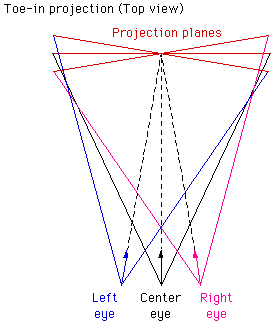
The way to identify whether or not a stereo pair have been created this way is to look for vertical parallax towards the corners of the image. A correctly rendered stereo pair will not have any vertical parallax but a toe-in stereo pair will have increasing amounts of vertical shift as one moves towards the corners. Positive, zero, and negative parallaxIn what follows the projection plane will be drawn at a set distance from the camera which is often called the focal length but which is better described as the distance for zero parallax. As per the standard pinhole perspective camera, the position on the projection plan of a point in the scene is given by the intersection on the projection plane of a line that passes from the eye to the point in question. The case where the object is behind the projection plane is illustrated below. The projection for the left eye is on the left and the projection for the right eye is on the right, the distance between the left and right eye projections is called the horizontal parallax. Since the projections are on the same side as the respective eyes, it is called a positive parallax. Note that the maximum positive parallax occurs when the object is at infinity, at this point the horizontal parallax is equal to the interocular distance. 
If an object is located in front of the projection plane then the projection for the left eye is on the right and the projection for the right eye is on the left. This is known as negative horizontal parallax. Note that a negative horizontal parallax equal to the interocular distance occurs when the object is half way between the projection plane and the center of the eyes. As the object moves closer to the viewer the negative horizontal parallax increases to infinity. 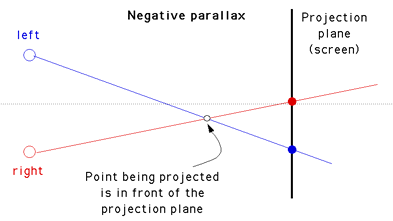
If an object lies at the projection plane then its projection onto the focal plane is coincident for both the left and right eye, hence zero parallax. 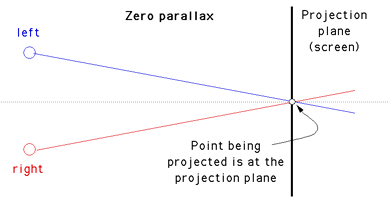
So, if on object rendered onto a stereo pairhas positive parallax then it will appear behind the screen it is porject onto. If the object appears on the stereo pairs in negative parallax then it will appear to be in front of the screen. Objects that appear in the stereo pairs at the same place have zero parallax and will appear to be at the same depth as the screen. The remaining issue to how to choose the correct eye separation and focal length. This becomes easier with experience. An approach that will work most of the time is to decide on the focal length (distance of zero parallax), this intuitively makes sense because it is directly related to the composition of the scene and which parts one intends to be in front or behind the screen. Once the focal length is chosen set the eye separation to 1/30 of that distance. This will generally result is good safe stereo on any stereo projection system. As the stereo projection system improves one can separate the eyes further for an enhanced effect. There is another limiting factor, that is, how close objects can be brought towards the camera. Unlike objects at infinity which only ever separate by the eye separation, objects become increasingly separated as they are brought towards the camera. At some point the two objects will cease to be recognised by the visual system as one stereo pair of the same object. For safe stereo it is generally considered unwise to bring objects closer that half the focal length. The better the stereo projection system, in particular, the degree of ghosting, the closer objects can be brought. Since the extend to which stereo pairs can be fused varies from person to person, pushing stereo separation to the limit is not considered "good form". | ||||